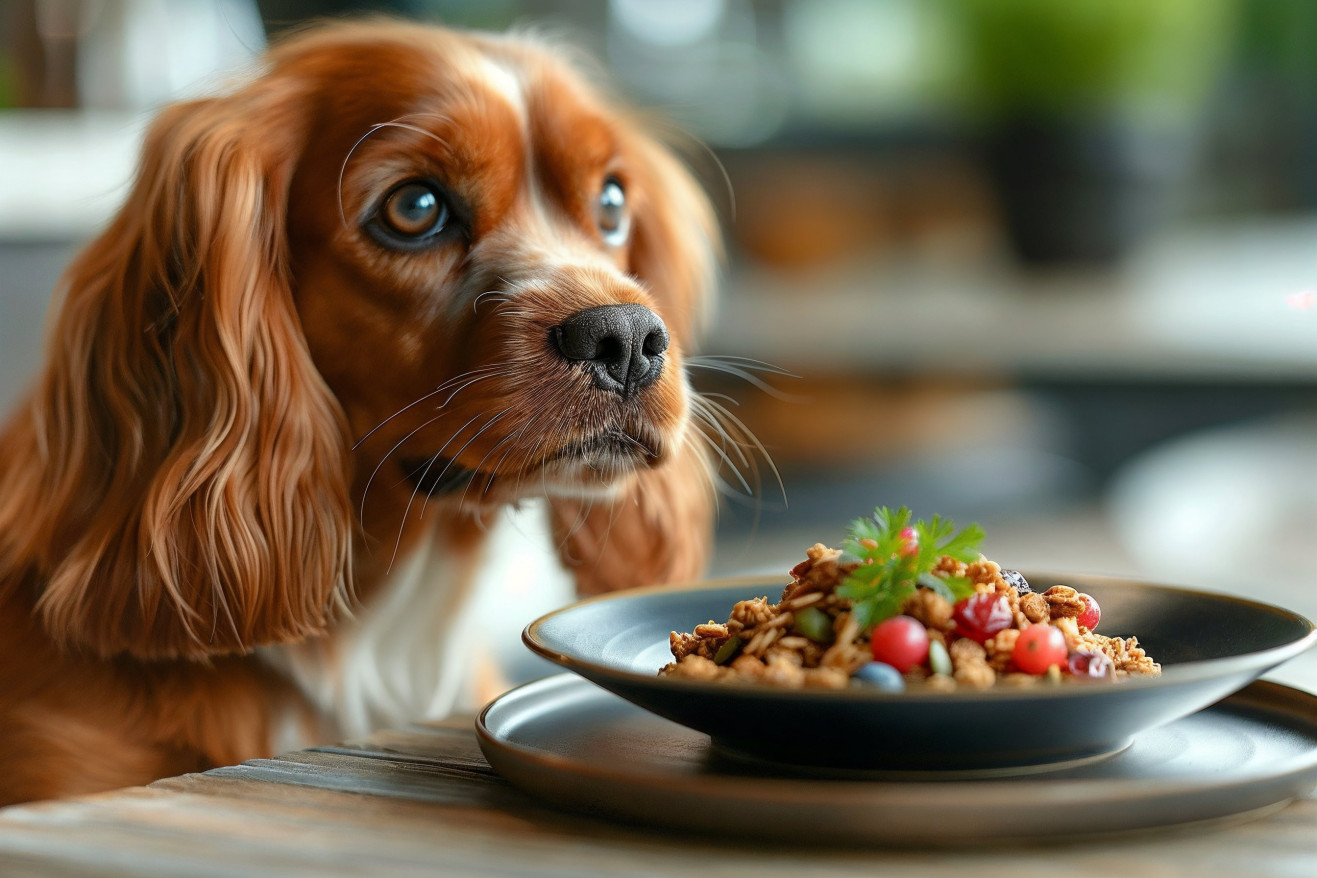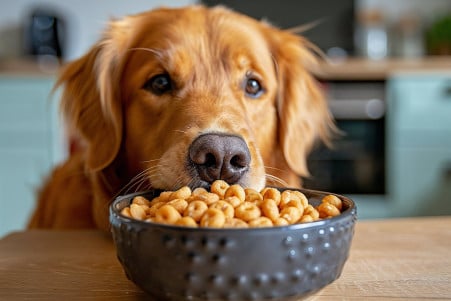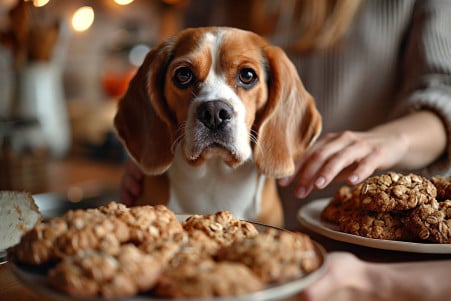Can Dogs Have Granola? What to Know About Healthy Dog Treats
12 February 2024 • Updated 12 February 2024

Granola’s satisfying crunch can make it hard to resist, but is it OK to share your granola with your dog? Dogs can have granola in small amounts, as long as it doesn’t contain ingredients that are toxic to dogs, like chocolate, raisins, or xylitol.
Unflavored granola made with oats and honey is safe for dogs, but it’s best to steer clear of granolas with added sugar and nuts. As always, it’s important to talk to your vet before adding anything new to your dog’s diet.
This article will review the latest in veterinary nutrition research and take a deep dive into the specifics of a dog’s nutritional needs. We’ll look at research to determine how the ingredients in granola impact a dog’s health overall.
By learning about the nutritional science of a dog’s diet, we can understand the roles of fiber, proteins, and potential allergens, and provide evidence-based recommendations for what makes a safe and healthy treat for your furry friend.
Can dogs have granola?
Nutritional Requirements for Dogs
A well-rounded diet for dogs includes a number of different nutrients, all of which are important to their health and well-being. The American Association of Feed Control Officials (AAFCO) lists protein, carbohydrates, fats, vitamins, minerals, and water as the six essential components of a dog’s diet, and each of these has a specific purpose in a dog’s body.
For example, proteins are important for tissue repair and muscle maintenance, and dogs need at least 13 of the 23 essential amino acids in their diet, according to the Clinical Nutrition Service at Cummings School.
Fats, including essential fatty acids such as Omega-3 and Omega-6, are a source of energy and help maintain skin and coat health. Carbohydrates are a source of energy and help maintain gut health, according to a WebMD article on dog nutrition.
Meanwhile, vitamins and minerals are important for a number of bodily functions, including bone health and metabolism. It’s also important to note that dogs can produce some vitamins, such as Vitamin C, so they don’t need to get them from their diet.
Water is also important for a dog’s health and makes up more than 50% of an adult dog’s body weight. It’s important to make sure your dog has access to fresh water at all times, and that water should be paired with a well-balanced diet that meets AAFCO’s guidelines.
In addition, dog owners should adjust their dog’s feeding based on their dog’s size and activity level, and they should make sure that no more than 10% of their dog’s daily calories come from treats.
Knowing these nutritional basics is important, especially when it comes to adding treats like granola to your dog’s diet, which we’ll explore in more detail below, including what granola is made of and whether it’s safe for dogs to eat.
How to Read Granola Ingredients for Dogs
Not all granola ingredients are created equal when it comes to your dog’s health. For example, oats are a good source of soluble fiber and important nutrients like iron, zinc, and B vitamins, which are important for healthy skin and coat. According to PetMD, plain cooked oatmeal, which is a main ingredient in granola, can even help with digestion and weight management in dogs.
That said, you need to be careful about the nuts and sweeteners that are often included in granola. According to Preventive Vet, while some nuts like plain peanuts and hazelnuts can be safe in small amounts, others can be very dangerous.
Macadamia nuts, almonds, and walnuts are all toxic and can also be a choking or blockage hazard. Pawlicy Advisor also suggests avoiding nuts that have coatings or are high in fat, as they can cause pancreatitis.
Sweeteners are another concern, with xylitol being especially dangerous for dogs. In addition, too much sugar can lead to a variety of health problems. So, make sure that the granola you give your dog is free of dangerous additives and xylitol.
You also need to make sure that it doesn’t have too much sugar. You also need to make sure that you don’t give your dog too much of a good thing. While a high fiber content is generally good for your dog, too much can cause digestive problems.
However, with the right selection and portion control, you can make granola a safe occasional treat for your dog, which leads to a discussion of the more complex topic of fiber in a dog’s diet.
The Role of Fiber in Your Dog’s Diet
Fiber is an important part of your dog’s diet because it helps maintain a healthy digestive system. It provides bulk that helps regulate bowel movements and ensures that stools are well-formed.
Soluble fiber, which can be dissolved in water, is also a prebiotic that feeds the good bacteria in the gut, according to The Farmer’s Dog. On the other hand, insoluble fiber can’t be dissolved in water, but it does help add bulk to stools and maintain regularity in the intestines.
The right balance of soluble and insoluble fiber can also help manage weight by making your dog feel full without adding extra calories.
That said, it’s important not to overdo it because too much fiber can lead to health issues like diarrhea, bloating, and a decrease in nutrient absorption.
It may take some trial and error to find the right balance of fiber for your dog since different dogs may react differently to different fiber sources. According to Dr. Laci Schaible, some signs that your dog may have too much or too little fiber in their diet include constipation, diarrhea, or accidents in the house.
When adding fiber-rich foods like granola to your dog’s diet, it’s important to do so in a way that won’t overwhelm their digestive system. Look for granola that’s made with safe, natural ingredients and start by feeding your dog small amounts so you can see how they react.
And, as always, talk to your vet before making any changes to your dog’s diet to make sure that any new additions, including granola, will be good for your dog and won’t throw off their nutritional balance.
Healthy Snack Options for Your Dog
Like with any treat, granola should be fed to your dog in moderation. According to Spoiled Hounds, granola can be a healthy treat for dogs if it doesn’t contain any harmful ingredients and is fed to dogs in small amounts.
That said, granola should not make up a large part of your dog’s diet. In general, it’s recommended that treats adhere to the 10% calorie guideline, which means that they should make up no more than 10% of your dog’s daily caloric intake to ensure that they’re eating a well-balanced diet.
For healthier snack options, you can try feeding your dog plain, cooked oatmeal or homemade granola bars made from recipes that have been approved by a vet, such as those that can be found at 3mbakery.com. These options can provide the same crunch and nutritional value as store-bought granola without the added sugars and other harmful ingredients.
A-Z Animals also notes that it’s important to avoid feeding your dog ingredients that are toxic to them, such as chocolate, raisins, and certain nuts, which are often found in granola bars or granola mixes.
It’s important to read pet food labels carefully when choosing any treat. Look for treats that are made from simple ingredients that you’re familiar with, have low sugar and sodium levels, and don’t contain artificial sweeteners like xylitol. Not only will this help protect your dog’s health, but it will also help them develop healthy eating habits.
Conclusion: Granola for Dogs
As we’ve discussed, granola can be a healthy dog treat if you choose the right kind and feed it to your dog in moderation. Just make sure that you choose a granola that doesn’t contain chocolate, raisins, artificial sweeteners like xylitol, and added sugars.
All of which can be harmful to your dog. The primary ingredients in granola, oats and brown rice, are generally safe and can even be good sources of fiber to help with digestion, according to DogTime.
Of course, being a good dog owner means more than just loving and caring for your pet; it also means knowing and meeting your dog’s individual nutritional needs. Always check with your vet before you give your dog new foods like granola to make sure that you’re choosing the right option for your pet.
And even if your vet gives you the go-ahead, it’s always best to start with small amounts and monitor your dog for any negative side effects, as recommended by World Dog Finder.
In the end, by being aware of what’s in granola and following nutritional recommendations, you can enjoy treating your dog to life’s little indulgences while also making sure that they’re happy and healthy.


